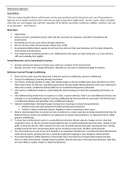Behaviourist Approach
Assumptions
“Give me a dozen healthy infants, well-formed, and my own specified world to bring them up in and I’ll guarantee to
take any one at random and train him to become any type of specialist I might select—doctor, lawyer, artist, merchant-
chief and, yes, even beggar-man and thief, regardless of his talents, penchants, tendencies, abilities, vocations, and race
of his ancestors.” -John Watson
Blank Slate
Tabula Rasa
Infants are born completely neutral, with only the most basic of responses, and will be moulded by the
environment
Everything you are has come about through experience
We are not born with internal mental content such as IMP
Environmental Determinism; people do not have free will over their own behaviour as it has been shaped by
environment and experience
If we experienced something horrific in our childhood this will impact our later behaviour, e.g. if you fall off a
cliff you’ll probably fear heights.
Animal Behaviour can be Generalised to Humans
Animals and humans behave in similar ways, both are a product of the environment
Humans can learn more complex behaviour, therefore we can test on animals and apply to humans.
Behaviour Learned Through Conditioning
There are two main ways that behaviour is learned: operant conditioning, operant conditioning
Classical Conditioning is learning through association
Ivan Pavlov. Studying salivation in dogs, after being brought to the lab multiple times they salivated even when
there wasn’t food. If a bell was rung before given food, the dog would salivate whenever there was a bell even if
there was no food. Conditioned Stimuli (Bell) lead to Conditioned Responses (Salivation)
John Garcia, conditioned coyotes to avoid eating life stock by laying out meat with nauseating chemicals in as
bait.
Unconditioned Dog would have no response to a bell, a neutral stimulus. Food is an unconditioned stimulus and
salivation is an unconditioned response. During conditioning the food and bell are associated. The bell becomes
a conditioned stimulus and salivating is the conditioned response.
Operant Conditioning is learning through consequences, focusing on reward and punishment.
Reinforcement increases behaviour/Punishment decreases behaviour
Positive is where something is given/ Negative is where something is taken away
Skinner demonstrated that an animal can learn to behave in a certain ways due to being rewarded with food. He
believed that our actions are shaped by our experience of reward and punishment, an approach that he called
operant conditioning.
To show how reinforcement works in a controlled environment, Skinner placed a hungry rat into a box that
contained a lever. As the rat scurried around inside the box, it would accidentally press the lever, causing a food
pellet to drop into the box. After several such runs, the rat quickly learned that upon entering the box, running
straight toward the lever and pressing down meant receiving a tasty snack. (Positive reinforcement)
The rat learned how to use a lever to its benefit in an unpleasant situation too: in another box that administered
small electric shocks, pressing the lever caused the unpleasant zapping to stop. (Negative reinforcement)
Social learning theory (Albert Bandura) is that people learn new behaviour through observational learning
factors in their environment. If people observe positive, desired outcomes in the observed behaviour, then they
are more likely to model, imitate or adopt the behaviour
, Relationship Formation
Operant Conditioning
A new relationship may be positively reinforcing in many ways, for example the compliments someone give us
or even being in their company can be rewarding. Thus, we are more likely to continue seeking their company
and pursuing a relationship with them.
We may also be motivated by unpleasant feelings of loneliness or rejection to seek a relationship. We may fear
punishment if we are not in a relationship, either by the judgement of others, or feeling left out from certain
activities. This punishment will decrease our want to be alone and increase the desire to be in a romantic
relationship.
Classical Conditioning
We may like people who are associated with pleasant events, not just those who directly cause pleasant
emotions. If we met someone on a good day when we were feeling happy, we would be more likely to want to
see them again than if we’d met them on a day we felt low.
Previously neutral stimulus, a person, can become positively valued because they are associated with a positive
event.
The control group were shown a series of images of their partners with neutral stimuli such as buttons, and
experimental had the partner photos with positive stimuli such as puppies, both groups were asked to press a
space bar when an image related with relationships flashed on the screen. Those in the experimental condition,
following conditioning, were more likely to say they were happy in their marriage. This demonstrates the role of
positive association in maintaining healthy relationships.
Pet-Owner Relationship
Principles of operant conditioning are used to train animals and create healthy pet-owner relationships.
For example, training Dogs usually involves rewarding good behaviour with a treat, such as waiting until a dog
sits until giving a reward. This increases contentment in the relationship for both the owner and pet and
therefore the behaviour is more likely to be repeated.
Studies have shown that people with treatment resistant depression are often helped by the presence of a pet
and that people with pets have lower blood pressure in stressful situations. Pets are associated then with
feelings of loyalty and companionship.





